Preparation, Characterization, and Life Cycle Assessment of Aerated Concrete Blocks: A Case Study in Guayaquil City, Ecuador
Abstract
:1. Introduction
2. Materials and Methods
2.1. Materials
2.2. Structural Design
- = area of nonprestressed longitudinal tension reinforcement.
- = specified yield strength for nonprestressed reinforcement.
- = distance from extreme compression fiber to centroid of longitudinal tension reinforcement.
- = depth of equivalent rectangular stress block.
2.3. Cycle Analysis
- Definition of the Objective and Scope: The objectives were to quantify the environmental impacts associated with the production phase (which includes the supply of raw materials, transport, and manufacturing) and the construction phase (which includes transport and construction/installation processes) of a two-story single-family house with an area of 42 m2 and identify the alternative (masonry with conventional and aerated autoclaved concrete blocks) that contributes to a lesser extent to the impact categories considered. The system’s limits are defined in the EN 15804 standard [26]. The construction of the house comprises processes that consider all the elements, raw materials, and components that comprise it. Therefore, they are affected by the flows of matter and energy during their useful life. For the limits of the system that were considered in this project, two phases can be distinguished (Figure 6): the production phase and the construction phase. The first phase includes the supply of raw materials, transportation, and manufacturing; on the other hand, the construction phase includes transportation and the construction/installation process [27].
- Life Cycle Inventory Analysis: Databases provided by Ecoinvent 3.6 (Table 4) were used to establish input and output flows (Table 5), taking as reference the diagram of the system limits (Figure 6). Additionally, the database of a study carried out on the analysis of the life cycle of clinker, cement, and concrete in Ecuador, and of electricity, was used [28] (which includes all types of power plants that are in the country considering the national energy balance of 2018 [29]). The quantities and the transport to the construction site of the materials corresponding to the construction of the gray work of the structure (such as formwork, reinforcing steel, concrete, and blocks) were calculated. Other necessary data were taken from the available inventory, carried out in 2017, of the construction of a hostel located in Lima, Peru. In this analysis, it was assumed that 1.39 kWh/m3 of diesel, 0.30 kWh/m3 of electricity, [30] and 0.5 kL/m2 of water [31] are necessary for the construction of a building. The data was recalculated for a construction area of 42 m2 (Table 5).
- Life Cycle Impact Assessment: ReCiPe is a method for impact assessment in an LCA. One of the ways to derive characterization factors is at the midpoint level; these indicators focus on single environmental problems [32]. For this study, the ReCiPe Midpoint impact analysis method was used, considering 5 impact indicators among 18: climate change, terrestrial acidification, marine eutrophication, freshwater eutrophication, and photochemical oxidant formation.
- Climate Change—GWP100: Because of climate change, a variety of environmental mechanisms are produced that generate effects on both human health and the health of the ecosystem. The method described above considers the marginal effect of a considerably small amount of CO2 and other greenhouse gases [33]. The reference unit is kg of CO2 equivalent.
- Terrestrial Acidification—TAP100: Substances such as sulfates, nitrates, and phosphates, which persist in the atmosphere, cause a change in the soil’s acidity. A significant deviation from this factor is detrimental to most plant species, as most have an optimal amount of defined acidity. Consequently, due to the variation in acidity levels, changes are generated in the composition of the species. The primary acidifying emissions are NOx, NH3, and SO2 [34]. The unit of measurement is kg SO2 equivalents.
- Freshwater Eutrophication—FEP: Eutrophication is an environmental problem that mainly affects lakes and reservoirs. These are affected due to the variety of activities related to man, such as agriculture and mining, which negatively affect the resource. This phenomenon is caused by the increase in nutrients, usually nitrogen and phosphorus, limiting their use [35]. The unit of measurement is kg of P equivalents.
- Photochemical Oxidant Formation—POFP: Photochemical oxidants are found in photochemical smog (a mixture of primary and secondary atmospheric pollutants), which refer to secondary air pollutants produced by the action of sunlight on nitrogen oxides, reactive hydrocarbons, and their precursors. Ozone and peroxyacetyl nitrate are the main most-relevant phytotoxic components produced by these photochemical reactions [36]. The reference unit is kg NMVOC equivalents.
3. Results and Discussion
3.1. Structural
3.2. Life Cycle Analysis
3.3. Project Budget
3.4. Project Activity Schedule
4. Conclusions
5. Recommendations
Author Contributions
Funding
Institutional Review Board Statement
Informed Consent Statement
Data Availability Statement
Acknowledgments
Conflicts of Interest
Appendix A
Appendix B
References
- García Ochoa, J.; Quito Rodríguez, J.; Perdomo Moreno, J.; Universidad Cooperativa de Colombia. Obtenido de Análisis de la Huella de Carbono en la Construcción y su Impacto Sobre el Ambiente 2020. Available online: https://repository.ucc.edu.co/bitstream/20.500.12494/16031/2/2020_Analisis_huella_carbono.pdf (accessed on 23 May 2021).
- Global Alliance for Buildings and Construction. 2019 Global Status: Report for Buildings and Construction. Available online: https://globalabc.org/sites/default/files/2020-03/GSR2019.pdf (accessed on 28 May 2021).
- Kosmatka, S.; Wilzon, M. Design and Control of Concrete Mixtures: The Guide to Applications, Methods, and Materials; Cement Association: Portland, IL, USA, 2011. [Google Scholar]
- Kibert, C.J. The next generation of sustainable construction. Build. Res. Inf. 2007, 36, 595–601. [Google Scholar] [CrossRef]
- Lucero, K. La Construcción, un Pilar de la Economía Debilitado por la Pandemia. Gestión. 2020. Available online: https://www.revistagestion.ec/economia-y-finanzas-analisis/la-construccion-un-pilar-de-la-economia-debilitado-por-la-pandemia (accessed on 12 May 2021).
- Instituto Nacional de Estadísticas y Censos. Ecuador en Cifras 2016. Available online: https://www.ecuadorencifras.gob.ec/documentos/web-inec/Estadisticas_Economicas/Encuesta_Edificaciones/2016/2016_EDIFICACIONES_PRESENTACION.pdf (accessed on 10 June 2021).
- Instituto Ecuatoriano de Normalización (Ecuadorian Normalization Institute). NTE INEN 2380: Cemento Hidráulico, Requisitos de Desempeño para Cementos Hidráulicos; INEN: Quito, Ecuador, 2011. [Google Scholar]
- Alexander, M.; Mindess, S. Aggregates in Concrete; Taylor & Francis Group: New York, NY, USA, 2005. [Google Scholar]
- Abbès, F.; Abbès, B.; Benkabou, R.; Asroun, A. A FEM Multiscale Homogenization Procedure using Nanoindentation for High Performance Concrete. J. Appl. Comput. Mech. 2020, 6, 493–504. [Google Scholar]
- Benkabou, R.; Abbès, F.; Asroun, A.; Li, Y. Contribution of 3D numerical simulatio of instrumented indentation testing in the identification of elastic-viscoplastic behaviour law of a high-performance concrete. Matériaux Tech. 2017, 105, 102. [Google Scholar] [CrossRef]
- Da Silva, W.E.L.; Němeček, J.; Štemberk, P. Application of multiscale elastic homogenization based on nanoindentation for high performance concrete. Adv. Eng. Softw. 2013, 62, 109–118. [Google Scholar] [CrossRef]
- Santisteban, I.A. Maquinaria y Equipos para la Industria Maderera en Ecuador; ICEX España Exportacion e Inversiones: Quito, Ecuador, 2019. [Google Scholar]
- Cabrera, M.I. Utilización de los Concretos de Alta Resistencia y Concretos Celulares en la Industria de la Construcción Ecuatoriana, Clasificados por Sectores: Vivienda, Electricidad, Gas/Petróleo, Salud y Educación; Revista Digital Universidad Central del Ecuador: Quito, Ecuador, 2015. [Google Scholar]
- Célere, V. Estimación de Huella Hídrica de Una Promoción Residencial; Comunidad ISM: Madrid, Spain, 2019. [Google Scholar]
- Remigio, C.; Abel, S. Análisis de Ciclo de Vida de Una Vivienda Unifamiliar en Huancayo; Pontificia Universidad Catolica del Peru: Lima, Peru, 2016. [Google Scholar]
- Instituto Ecuatoriano de Normalización. NTE INEN 638: Bloques Huecos de Hormigón. Definiciones, Clasificación y Condiciones Generals; INEN: Quito, Ecuador, 2014. [Google Scholar]
- Norma Ecuatoriana de la Construcción. NEC-SE-DS: Peligro Sísmico. Diseño Sismorresistente; NEC: Quito, Ecuador, 2015. [Google Scholar]
- American Concrete Institute. ACI 318-14: Building Code Requirements for Structural Concrete and Commentary; ACI: Indianapolis, IN, USA, 2014. [Google Scholar]
- Ministerio de Desarrollo Urbano y Vivienda. Guía de Práctica para el Diseño de Estructuras de Hormigón Armado de Conformidad con la Norma Ecuatoriana de la Construcción NEC 2015; MIDUVI: Quito, Ecuador, 2016. [Google Scholar]
- Norma Ecuatoriana de la Construcción. NEC-SE-CG: Cargas (No Sísmicas); NEC: Quito, Ecuador, 2015. [Google Scholar]
- Norma Ecuatoriana de la Construcción. NEC-SE-VIVIENDA: Viviendas de Hasta 2 Pisos con Luces de Hasta 5 m; NEC: Quito, Ecuador, 2015. [Google Scholar]
- ISO 14040; Environmental Management—Life Cycle Assessment—Principles and Framwork. International Organization for Standardization: Geneva, Switzerland, 2006.
- Aranda Usón, A.; Zabalza Bribián, I. Ecodiseño y Análisis de Ciclo de Vida; Prensas Universitarias: Zaragoza, Spain, 2010. [Google Scholar]
- Curran, M.A. Life Cycle Assessment Handbook: A Guide for Environmentally Sustainable; Wiley: New Jersey, NJ, USA, 2012. [Google Scholar]
- ISO 14044; Environmental Management—Life Cycle Assessment—Requirements and Guidelines. International Organization for Standardization: Geneva, Switzerland, 2006.
- EN 15804; Sustainability of Construction Works—Environmental Product Declarations—Core Rules for the Product Category of Construction Products. European Standards. British Standards Institute Staff: London, UK, 2012.
- León, K.P. Análsis de Ciclo de Vida de Una Vivienda de Tipo Media en la Ciudad de Guayaquil; Espol: Guayaquil, Ecuador, 2016. [Google Scholar]
- Petroche Sánchez, D. Desempeño Ambiental del Cemento y del Concreto en el Ecuador: Una Puerta a la Construcción Sostenible; Escuela Superior Politecnica del Litoral: Guayaquil, Ecuador, 2020. [Google Scholar]
- Ramirez, A. Life cycle methods to analyze the environmental sustainability of electricity generation in Ecuador: Is decarbonization the right path? Renew. Sustain. Energy Rev. Ecuad. 2020, 134, 110373. [Google Scholar] [CrossRef]
- Zabalza, I.; Scarpellini, S.; Aranda, A.; Llera, E.; Jáñez, A. Use of LCA as a Tool for Building Ecodesign. A Case Study of a Low Energy Building in Spain. Energies 2013, 6, 3901–3921. [Google Scholar] [CrossRef] [Green Version]
- Crawford, R.; Treloar, G. An Assessment of the Energy and Water Embodied in Commercial Building Construction; Australian Life Cycle Assessment Society: Sydney, Australia, 2005. [Google Scholar]
- Huijbregts, M.A.; Steinmann, Z.J.; Elshout, P.M.; Stam, G.; Verones, F.; Vieira, M.; Van Zelm, R. ReCiPe2016: A harmonised life cycle impact assessment method at midpoint and endpoint level. Int. J. Life Cycle Assess. 2017, 22, 138–147. [Google Scholar] [CrossRef]
- Goedkoop, M.; Heijungs, R.; Huijbregts, M.; Schryver, A.D.; Struijs, J.V.Z.R.; Van Zelm, R. ReCiPe 2008: A Life Cycle Impact Assessment Method which Comprises Harmonised Category Indicators at the Midpoint and the Endpoint Level; Ministerie van Volkshuisvesting, Ruimtelijke Ordening en Milieubeheer: The Hague, The Netherlands, 2008.
- Van Zelm, R.; Preiss, P.; Van Goethem, T.; Van Dingenen, R.; Huijbregts, M.A.J. Regionalized life cycle impact assessment of air pollution on the global scale: Damage to human health and vegetation. Atmos. Environ. 2016, 134, 129–137. [Google Scholar] [CrossRef] [Green Version]
- Ledesma, C. Determinación de indicadores de eutrofización en el embalse Río Tercero. Córdoba Argent. Cienc. Agronómica 2013, 44, 419–420. [Google Scholar]
- Guderian, R.D. Effects of Photochemical Oxidants on Plants. Available online: https://cfpub.epa.gov/si/si_public_record_Report.cfm?Lab=NHEERL&dirEntryId=36285 (accessed on 24 May 2002).
- Velez, A.L. Energía contenida y emisiones de CO2 en el proceso de fabricación del cemento en Ecuador. Ambiente Construído 2020, 20, 611–625. [Google Scholar] [CrossRef]
- Hanle, L. Productos industriales y usos del producto: Emisiones de la industria de los minerales. In Directrices del IPCC de 2006 para los Inventarios Nacionales de Gases de Efecto Invernadero; ICAT Initiative for Climate Action Transparency: Geneva, Switzerland, 2006. [Google Scholar]
- Hidalgo, I. Technological prospects and CO2 emission trading analyses in the iron and steel industry: A global model. Energy 2005, 30, 583–610. [Google Scholar] [CrossRef]
- Guerra Jesús, B.N. Análisis de Ciclo de Vida de Una Vivienda Unifamiliar de Bambu; Pontificia Universidad Catolica del Peru: Lima, Peru, 2021. [Google Scholar]
- Solis Guzman, J. Metodología para determinar la huella ecológica de la construcción de edificios de uso residencial en España. In Proceedings of the Actas del I Congreso Internacional de Construcción Sostenible y Soluciones Eco-Eficientes, Sevilla, Spain, 20–22 May 2013. [Google Scholar]
- Ramos Espinoza, D.S. Análisis de Ciclo de Vida de Una Vivienda Unifamiliar en Cusco; Pontificia Universidad Catolica del Peru: Lima, Peru, 2018. [Google Scholar]


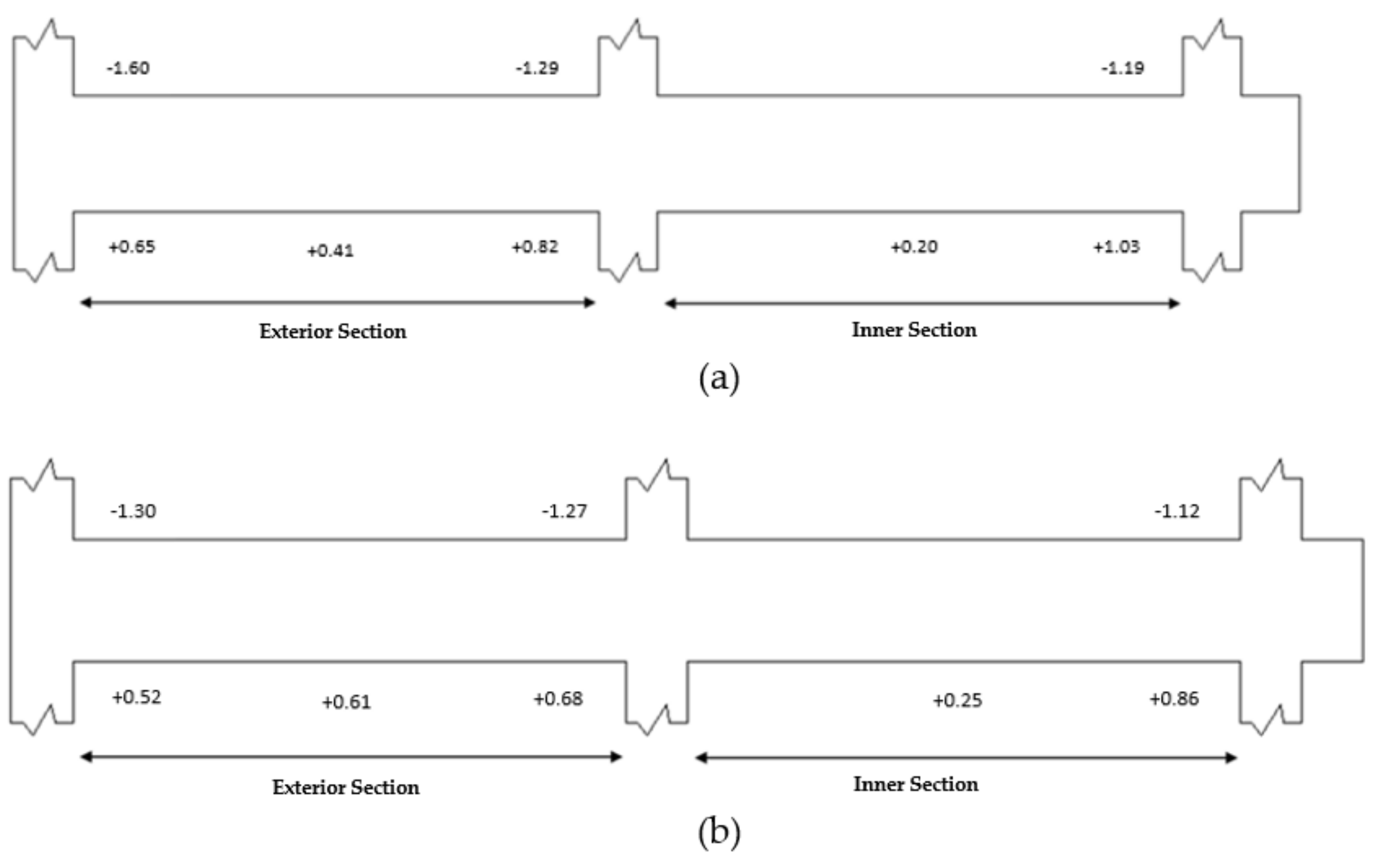
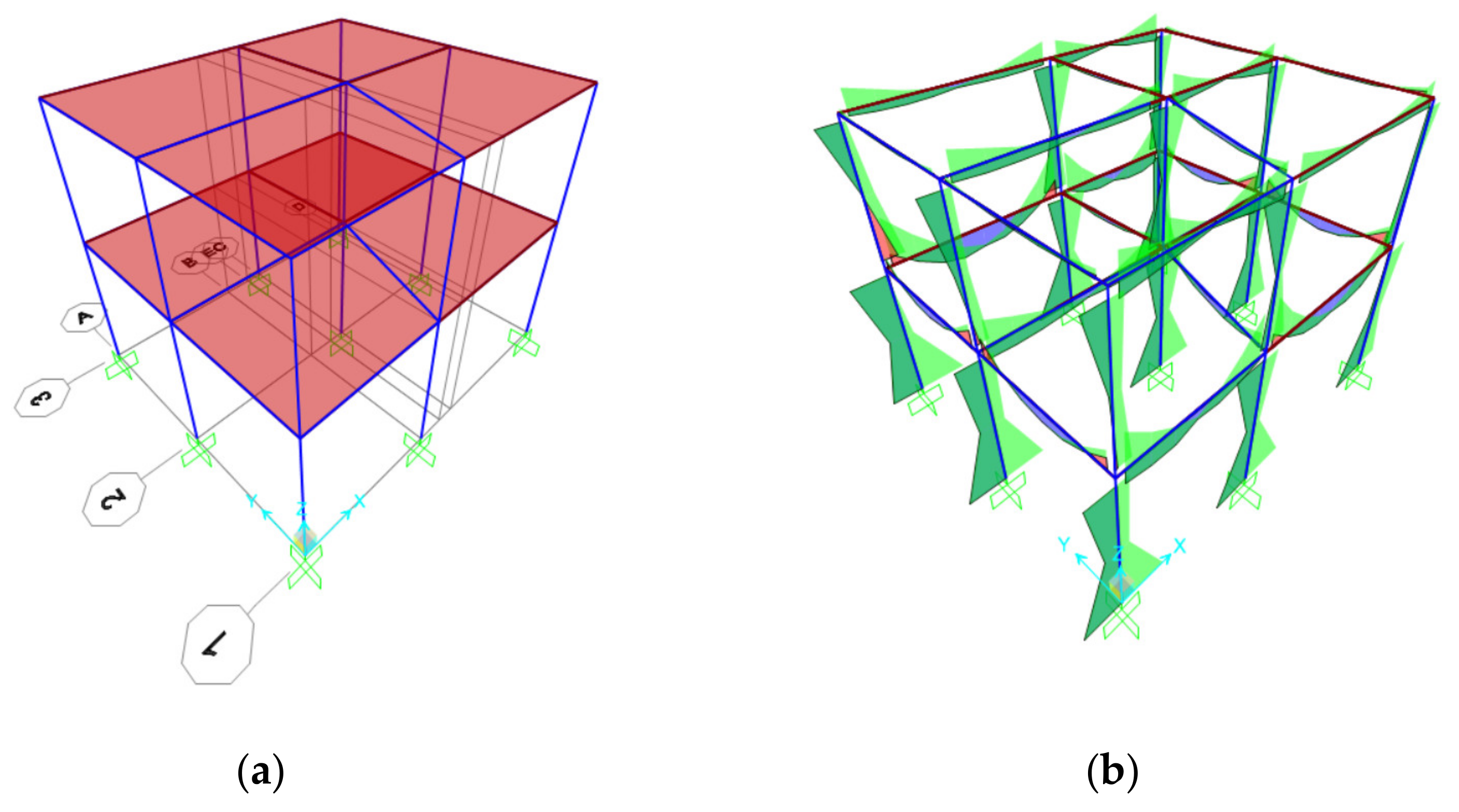
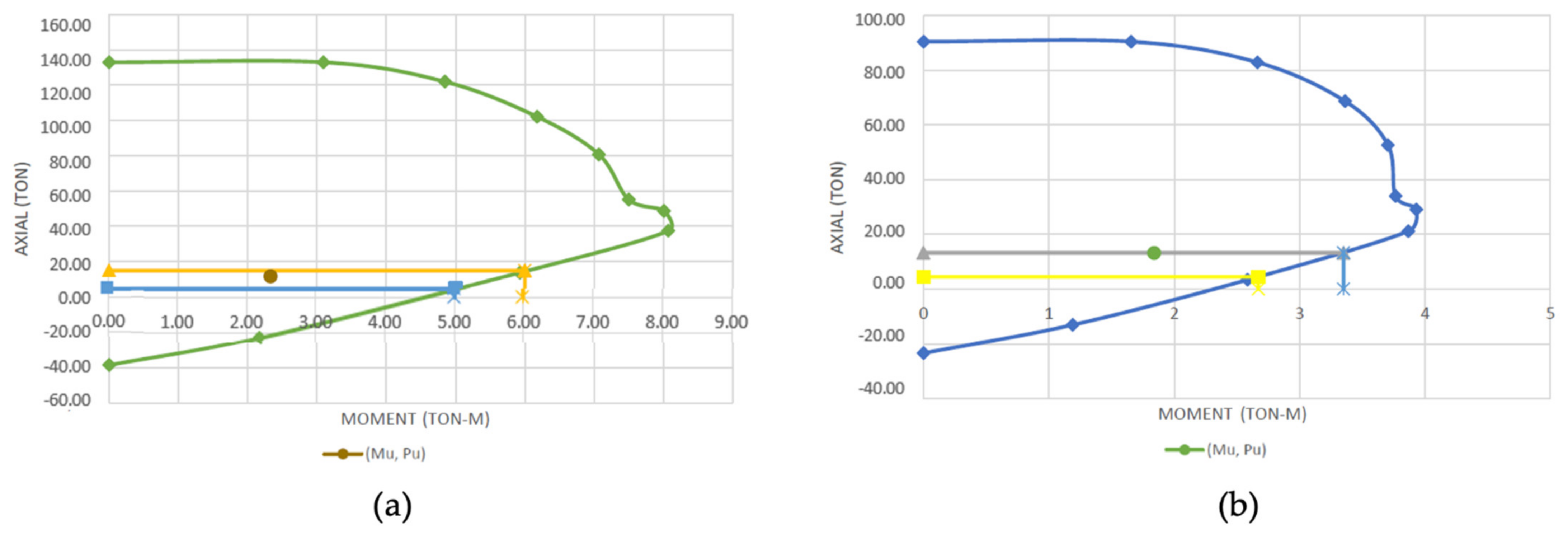
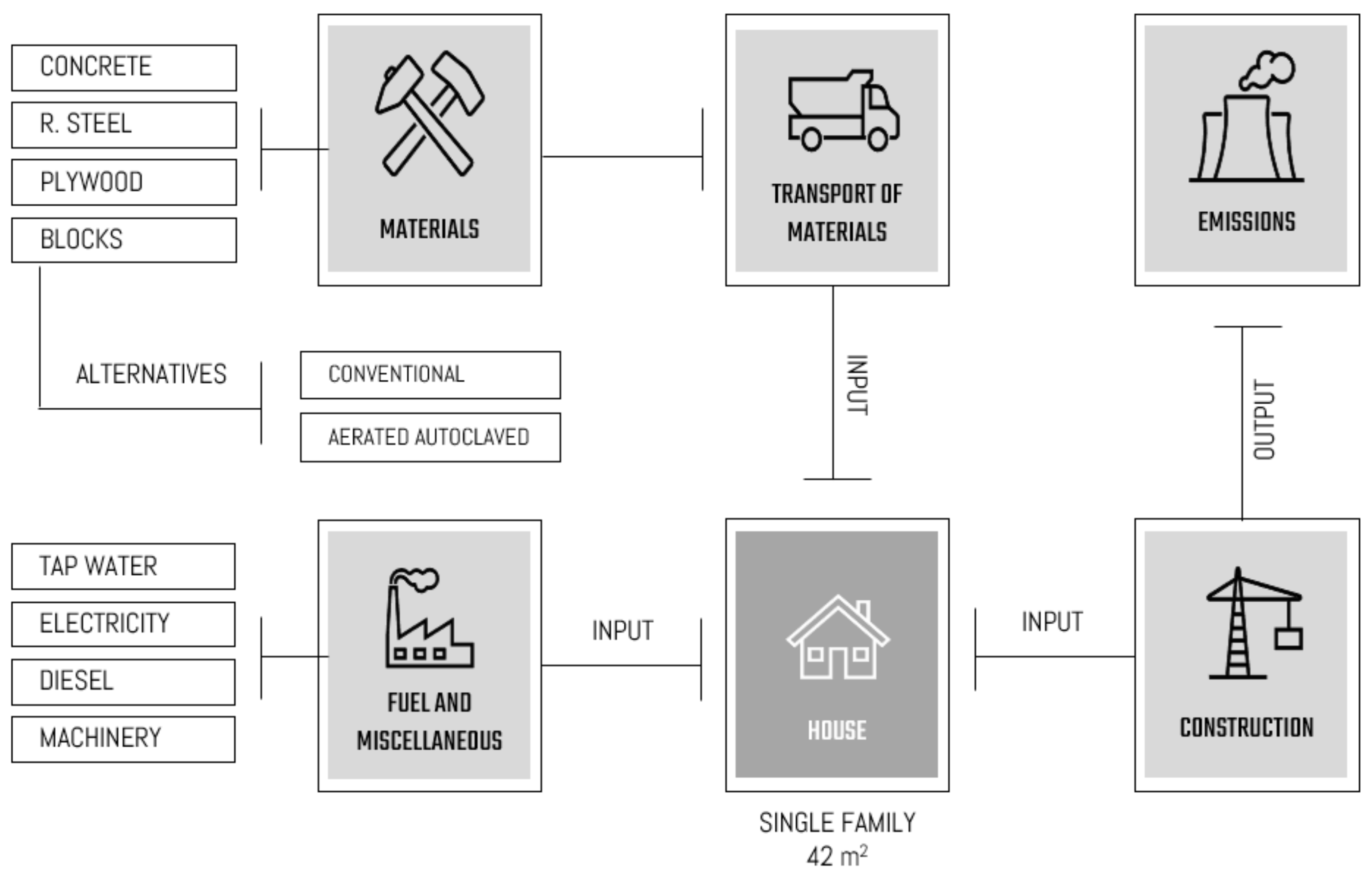
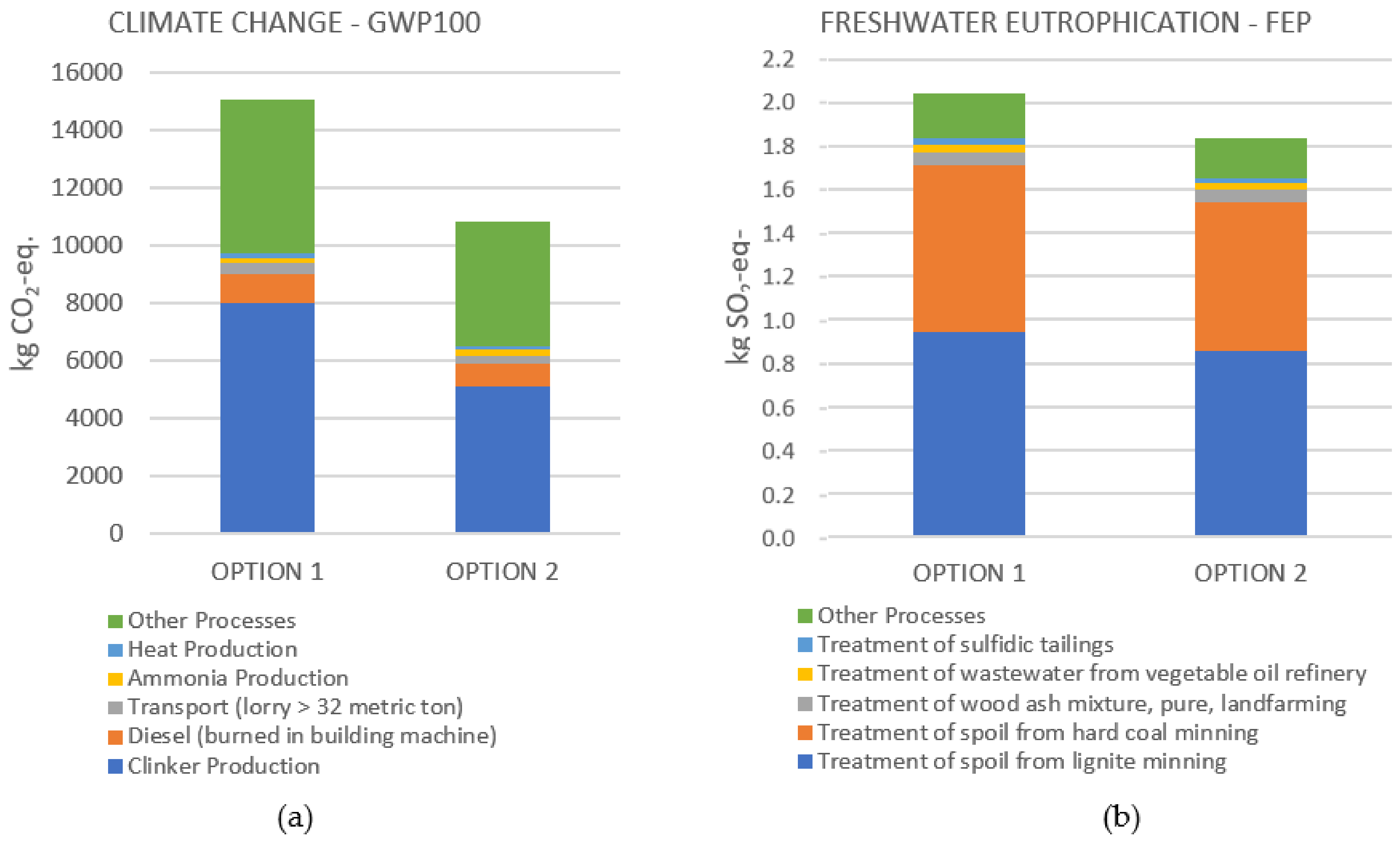
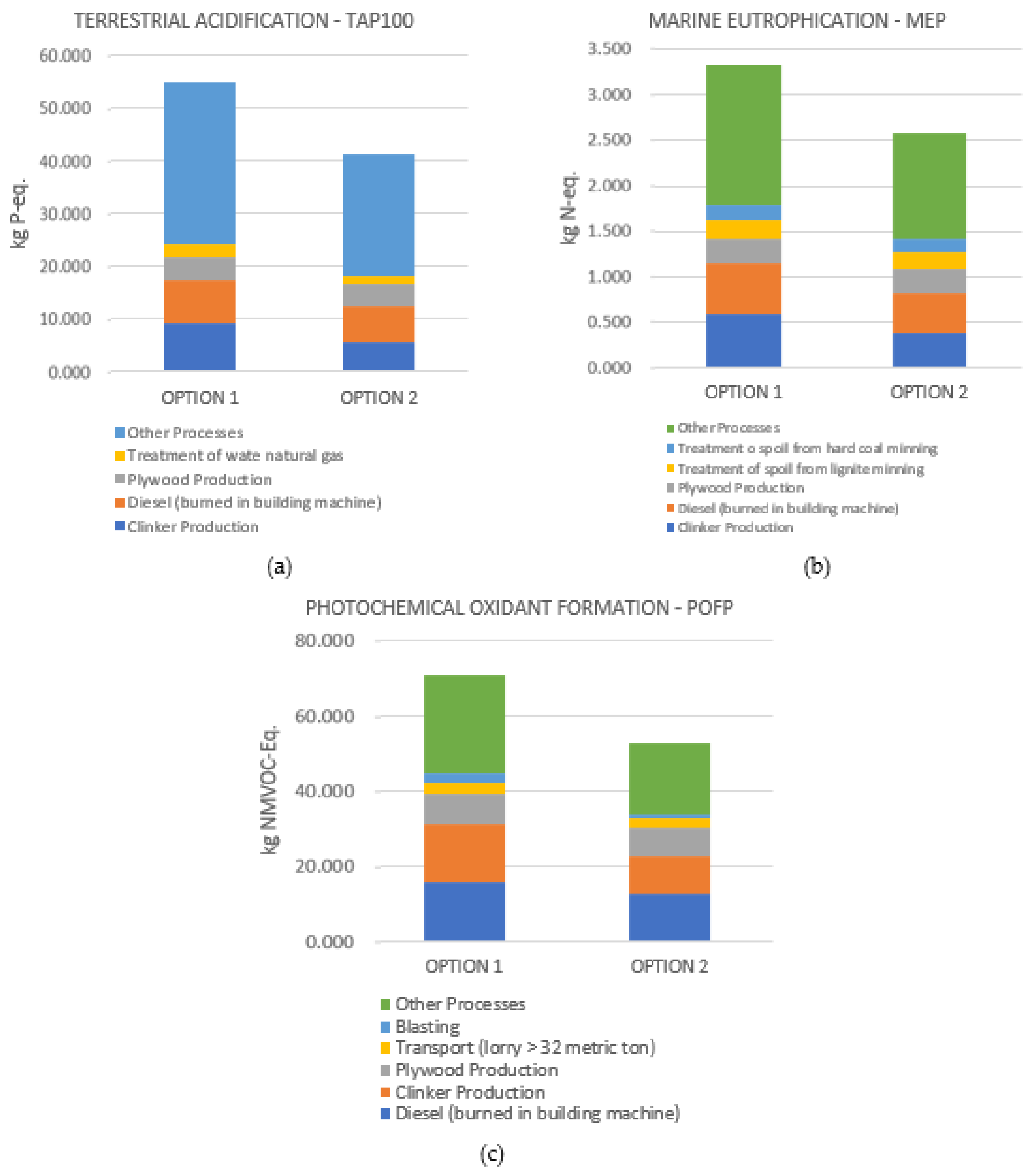
| Materials | Quantity (Conventional Concrete) kg | Quantity (Autoclaved Aerated Concrete) kg |
|---|---|---|
| Cement | 7.22% | 43.97% |
| Gravel | 24.12% | -- |
| Sand | 44.46% | 43.97% |
| Water | 24.20% | 0.68% |
| Additive 1 | -- | 0.04% |
| Additive 2 | -- | 0.13% |
| Aluminum Sulfate | -- | 0.22% |
| Foam | -- | 10.99% |
| Load | Description | Top Floor | Cover Floor | |
|---|---|---|---|---|
| Option 1 | Option 2 | Option 1 and 2 | ||
| Dead | Compression slab | 0.1200 | 0.1200 | 0.1200 |
| Nerves | 0.0720 | 0.0720 | 0.0720 | |
| Drawer (polystyrene sheets) | 0.0036 | 0.0036 | 0.0036 | |
| Walls | 0.3452 | 0.0900 | -- | |
| Ceramic tiles | 0.1000 | 0.1000 | -- | |
| Plastering, ducts, etc. | 0.0400 | 0.0400 | 0.0400 | |
| Flat roof tile with cement mortar | 0.0043 | |||
| Ceiling | 0.0200 | 0.0200 | 0.0200 | |
| Live | Single-family home | 0.2039 | 0.2039 | 0.0714 |
| Design Data | Option 1 | Option 2 |
|---|---|---|
| 11.66 | 13.23 | |
| 2.33 | 1.84 |
| Inflow | OpenLCA Ecoinvent Database | Description |
|---|---|---|
| Concrete blocks | concrete block production|concrete block|APOS, U-EC | Production of traditional blocks adapted to the environment of Ecuador. |
| aerated concrete block production|concrete block|APOS, U-EC | Production of non-traditional blocks adapted to the environment of Ecuador. | |
| Concrete, 25 MPa | concrete production, 25 MPa GYE, ready-mix, with cement, HE Type|concrete, 25 MPa|APOS, U-EC | Production of concrete with a resistance of 25 MPa, with type HE cement, adapted to the surroundings of Guayaquil, Ecuador. |
| Concrete, 28 MPa | concrete production, 28 MPa GYE, ready-mix, with cement, HE Type|concrete, 25 MPa|APOS, U-EC | Production of concrete with a resistance of 28 MPa, with type HE cement, adapted to the surroundings of Guayaquil, Ecuador. |
| Diesel | diesel, burned in building machine|diesel, burned in building machine|APOS, U-GLO | Diesel, adapted to the environment of Ecuador. Includes “construction machine” inputs for infrastructure, lubricating oil and fuel consumption, and some measured air emissions as output. |
| Electricity | Electricity, at supply, 2018 mix-EC | Generation and supply of electricity in Ecuador. |
| Plywood | Market for plywood|plywood|APOS, U-RoW | Plywood, adapted to the environment of Ecuador. This data set represents a generic plywood product. |
| Reinforcing steel | steel production, electric, low-alloyed|steel, low-allowed|APOS, U-EC | This dataset describes the average tap water available, per user, adapted to the Ecuadorian environment. |
| Tap water | market for tap water|tap water|APOS, U-PE | This dataset describes the average tap water available, per user, adapted to the Ecuadorian environment. |
| Transport | transport, freight, lorry > 32 metric ton, EURO3|transport, freight, lorry > 32 metric ton, EURO3|APOS, U-RoW | Transport adapted to the environment of Ecuador. Transport data sets refer to the entire transport life cycle, that is, the construction, operation, maintenance, and end of life of road and vehicle infrastructure. |
| Flow | Option 1 | Option 2 | Unit |
|---|---|---|---|
| Inputs | |||
| Fuel and electric power | |||
| Diesel | 629.549 | 629.549 | MJ |
| Electricity | 37.742 | 37.742 | kWh |
| Miscellaneous | |||
| Tap Water | 20,968.195 | 20,968.195 | kg |
| Materials | |||
| Plywood | 9.726 | 8.502 | m3 |
| Reinforcing steel | 2800.350 | 2581.020 | kg |
| Concrete, 25 MPa | 6.080 | 4.810 | m3 |
| Concrete, 28 MPa | 22.700 | 20.310 | m3 |
| Concrete block | 41,157.807 | 11,199.384 | kg |
| Transportation of materials | |||
| Reinforcing steel | 14.282 | 13.163 | tKm |
| Plywood | 48.784 | 42.643 | tKm |
| Concrete | 739.070 | 645.082 | tKm |
| Concrete blocks | 527.228 | 483.729 | tKm |
| Outputs | |||
| Wood waste | 1.843 | 1.843 | kg |
| Water waste | 274.584 | 274.584 | m3 |
| Material | Parameter | Option 1 | Option 2 | Reduction |
|---|---|---|---|---|
| Beams | Area (cm2) | 750 | 625 | 16.67% |
| Columns | Area (cm2) | 900 | 625 | 30.55% |
| Plinths | Area (cm2) | 24,266.67 | 20,216.67 | 16.69% |
| Slabs | t (cm) | 20 | 20 | 0.00% |
| Stairs | t (cm) | 25 | 25 | 0.00% |
| Environmental Indicator | Option 1 | Option 2 | Unit |
|---|---|---|---|
| Climate change—GWP100 | 15,041.867 | 10,824.000 | kg CO2-Eq |
| Terrestrial acidification—TAP100 | 54.915 | 35.609 | kg P-Eq |
| Freshwater eutrophication—FEP | 2.046 | 1.836 | kg SO2-Eq |
| Marine eutrophication—MEP | 3.332 | 2.197 | kg N-Eq |
| Photochemical oxidant formation—POFP | 70.396 | 52.657 | kg NMVOC-Eq |
Publisher’s Note: MDPI stays neutral with regard to jurisdictional claims in published maps and institutional affiliations. |
© 2022 by the authors. Licensee MDPI, Basel, Switzerland. This article is an open access article distributed under the terms and conditions of the Creative Commons Attribution (CC BY) license (https://creativecommons.org/licenses/by/4.0/).
Share and Cite
Reyes-Quijije, M.; Rocha-Tamayo, A.; García-Troncoso, N.; Baykara, H.; Cornejo, M.H. Preparation, Characterization, and Life Cycle Assessment of Aerated Concrete Blocks: A Case Study in Guayaquil City, Ecuador. Appl. Sci. 2022, 12, 1913. https://doi.org/10.3390/app12041913
Reyes-Quijije M, Rocha-Tamayo A, García-Troncoso N, Baykara H, Cornejo MH. Preparation, Characterization, and Life Cycle Assessment of Aerated Concrete Blocks: A Case Study in Guayaquil City, Ecuador. Applied Sciences. 2022; 12(4):1913. https://doi.org/10.3390/app12041913
Chicago/Turabian StyleReyes-Quijije, Melissa, Alid Rocha-Tamayo, Natividad García-Troncoso, Haci Baykara, and Mauricio H. Cornejo. 2022. "Preparation, Characterization, and Life Cycle Assessment of Aerated Concrete Blocks: A Case Study in Guayaquil City, Ecuador" Applied Sciences 12, no. 4: 1913. https://doi.org/10.3390/app12041913
APA StyleReyes-Quijije, M., Rocha-Tamayo, A., García-Troncoso, N., Baykara, H., & Cornejo, M. H. (2022). Preparation, Characterization, and Life Cycle Assessment of Aerated Concrete Blocks: A Case Study in Guayaquil City, Ecuador. Applied Sciences, 12(4), 1913. https://doi.org/10.3390/app12041913









